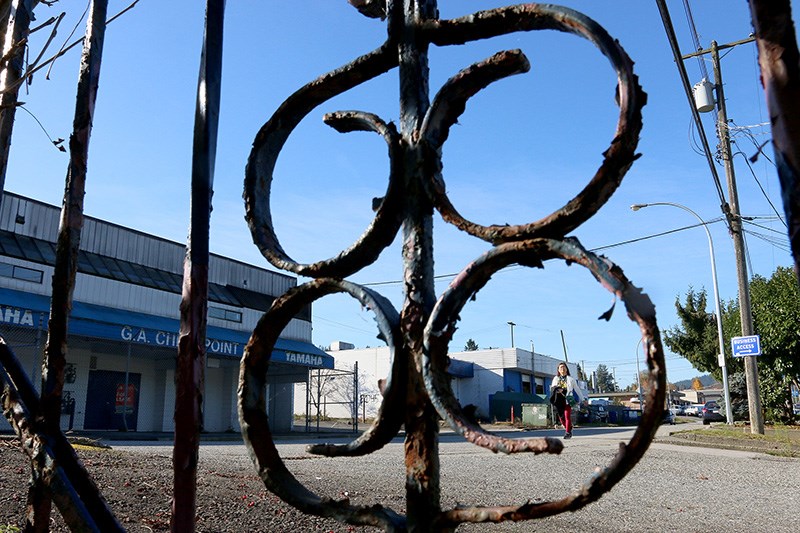For passengers of the Evergreen Extension and the West Coast Express, disembarking at Moody Centre station, there’s simply no there there.
Nearby Spring Street has no sidewalks. Not that there’s much reason to walk between the smattering of auto repair shops, strips of light industrial spaces, some small fitness gyms and several vacant buildings.
One street south, St. Johns, isn’t much more alluring for pedestrians, although it does have a sidewalk flanking its four lanes of busy traffic speeding through Port Moody.
It’s little wonder, then, Moody Centre is one of TransLink’s most under-utilized stations.
That’s about to change.
THE PLAN
A consortium of developers and property owners — including TransLink — with a stake in the 23-acre stretch between the SkyTrain station and St. Johns Street, and from Moody to Buller streets, that has become known as the Moody Centre Transit Oriented Development (TOD) area, is unveiling to the public its plans for the neighbourhood in two open houses. The first is tonight (Wednesday), and another will be held Saturday.
The product of nearly two years of quiet collaboration amongst its members and with city staff, the consortium envisions a dense urban neighbourhood with more than 3,700 homes in a series of condo towers whose residents will be able to use their convenient access to transit to get to jobs elsewhere.
Spring Street would become its spine. Wide sidewalks flanking a narrow, traffic-calmed roadway, would be lined with shops, services and offices that would create employment for 1,400 people. Pocket parks and an expansive plaza at the entrance to the SkyTrain station would give people places to gather. Old Dallas creek, currently hidden from view, would become a daylighted green space.
But some on Port Moody council have a different idea.
A TECH HUB?
They want fewer condo towers and more affordable units in the ones that do get built. They want residents to be able to stay in the neighbourhood to work at well-paying jobs for high-tech and education employers in spaces specially built for them. Other employees would stream into the neighbourhood from elsewhere in the region using transit.
Coun. Hunter Madsen, who championed the tech hub vision in a report he authored last summer, said it’s important the city get the TOD right because its redevelopment “presents the single-best opportunity that Port Moody will get to reinvent and revitalize its economic heart over the next half century.”
Peter Hall, a professor of urban studies at Simon Fraser University, said the ability of municipal governments to shape such economic growth is limited to zoning. But to make it happen, he said, developers have to buy in.
And that’s not guaranteed.
“That kind of strategy is the kind of thing developers think is risky,” Hall said, adding cities often dangle the idea of luring high-tech employers because “it sounds advanced” and “more palatable then another sawmill.”
Hall said the high value of property, especially near transit stations, makes it economically difficult for developers to build the kind of small, flexible and inexpensive spaces that would attract start-ups. As well, he said the need to densify near transit to accommodate regional growth and transportation strategies makes it a challenge to accommodate a large anchor that needs space to grow.
Port Moody’s Karn Manhas, whose Vancouver-based biotech company, Terramera, recently received a venture capital injection of $45 million, said from his start in a 100-sq. ft. basement lab in Port Coquitlam, he now needs about 100,000 sq. ft.
“It has to be scalable and it has to be there,” he said of the space requirements for growing tech companies. “Where you have transit, you have condos but not enough large spaces.”
THE EDUCATION SECTOR
Madsen, who also chairs Port Moody’s economic development committee, said there have already been “early conversations with a number of potentially interested businesses and academic institutions considering campus space” in the city that will be connected with the consortium of developers and property owners. He said the city can also do things like ensure its fibre network is top notch to increase its allure.
Still, it’s a competitive marketplace, SFU’s Hall said.
The False Creek Flats industrial area of Vancouver has been designated for high-tech development since the late 1990s but it's only recently that big institutions like Emily Carr University of Art and Design and Mountain Equipment Co-op have set roots in the 450-acre tract of land east of Main Street and north of Great Northern Way.
As well, earlier this month, the B.C. government announced an investment of several million dollars to help create an “innovation corridor” in Surrey, around that city’s SFU campus.
Hall said it takes “a bit of willingness to want to do something a bit different, and the city holding the line” to stand apart from other players.
Madsen said Port Moody has those tools. He said the city could bring some of its own land in the area to the table, and in September, council formed a new Moody Innovation Centre task force to spark conversations with provincial players like TransLink and the BC Transportation Finance Authority to create more space for a tech hub.
Even then, Manhas said, tech companies like his look at other factors as well, like being located amidst other like-minded tech companies, as well as amenities for employees.
“They want to be in a place where there’s a scene,” he said.
But, he added, in the tech sector that can be a moving target that always has companies on the alert for greener, more viable, pastures because “we don’t know what we’ll look like in five years.”



